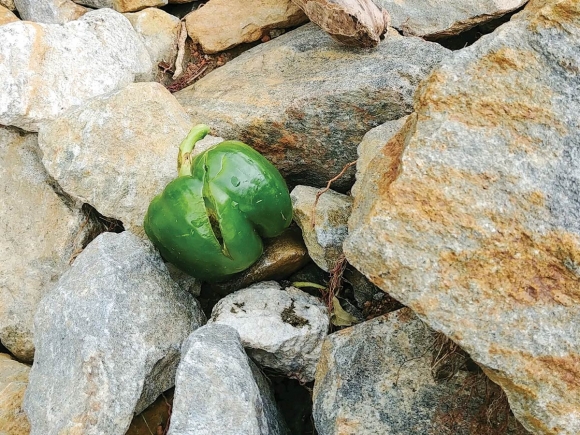This must be the place: Ode to the green peppers, ode to the people of Haywood
 A green pepper along the Pigeon River in Bethel. (photo: Garret K. Woodward)
A green pepper along the Pigeon River in Bethel. (photo: Garret K. Woodward)
The green peppers. All of those damn green peppers. Throughout the coverage of this devastating flood from Tropical Storm Fred last Tuesday here in Western North Carolina, I keep seeing green peppers. Everywhere.
The mighty Pigeon River rose over 20 feet from the torrential rain, pummeling the small outlying mountain communities of Cruso and Bethel, onward through downtown Canton and beyond.
A bulldozer of fast-paced water overtaking homes, businesses and outdoor recreational locations, forever shifting the appearance of the landscape and its habitants — death, destruction, a sea of mud and water.
And yet, on the riverbank. On the road. In front yards. In ditches. Atop bridges. And so forth: green peppers. Thousands and thousands of green peppers. I’ve seen the green peppers for miles and miles along the river and beyond. There are probably Haywood County green peppers in East Tennessee via the Pigeon by now.
I think of the farmland these green peppers were ripped from the earth. I think of the farmers who lost their entire crop mere weeks from harvest, let alone the economic hardship our local/regional agricultural sectors have faced during the pandemic. I think of the places and faces these green peppers have seen in their travels — near and far, for good or ill.
And also, I think of how we are all connected by the green peppers, this object we’ve constantly seen this week, whether as a flood survivor, law enforcement, volunteer, or journalist. As we navigate our way, whether physically or emotionally, through “all this,” there’s always a green pepper we’re stepping over, around or just out of the corner of our eye — a reminder of where we were, where we are, and where we may go from this point.
Related Items
I’ve also felt this deep sense of deflation during the flood coverage by our newspaper and via other media outlets. It has really shaken my personal and professional self to the core.
As a 15-year journalist, I’ve covered it all — people, places, and things — natural disasters included. And I’ve slowly meandered away from hard news coverage over the last decade, and for many reasons, most of which being the sense of deflation and helplessness that comes with covering these unexpected events.
An existential crisis of sorts always seems to rear its ugly head in moments like right now. It’s a lot more enticing to write about music, art and oddball characters (uplifting topics to promote positivity and passion) and turn your journalistic back to the dark clouds outside your front door.
It’s not that I’m ignoring everyday realities, I just found myself burned out on it years ago and never looked back. My ethos has been to champion the lightness of artistic endeavors to balance out the heaviness of hard news.
And yet, destruction in your own backyard is the hardest part of this gig, knowing you have to go into the unknown abyss, in an effort to track down other confused and shell-shocked human beings, to ask them questions with worried, empty eyes looking right back into yours.
You talk to them. Peel away the layers, only to jump into your truck, the one vehicle not covered in mud, and return to your quiet apartment in downtown Waynesville with electricity, clean water, food and beer in the fridge. This is not the case, well, back there where they sit and ponder the future as another day comes to a close.
You plop down at your desk in the apartment and go through the audio recordings. You sift through the pages of hastily scribbled notes of where you were and what you saw. Type wildly and with purpose. Publish the article. Sit back in your desk chair. Let out a big sigh. Do it all over again tomorrow.
Although I’ve been around the block in this business several times, this most recent event has shifted a lot of my mind, body and soul. I’m shook. I’m floating, trying to figure out where solid ground is. I will never be the same after this, and I’m just on the sidelines. Imagine those at the center of the madness. What now? Where to from here?
None of us here will ever forget Aug. 17, 2021. It is, by far, the most destructive natural disaster to hit our beloved Haywood County. Entire neighborhoods were destroyed. Cars mangled and flipped. Homes and bridges pushed into the fast-paced river. Lives lost. One person still unaccounted for.
And yet, it could still have been much worse had the flood happened at night or if Cruso didn’t have adequate cell service like it was notorious for lacking just a few years ago.
Now will begin a colossal cleanup effort that may take months (perhaps years) before some sense of normalcy returns to Cruso, Bethel and Canton. It was shocking and horrific.
But, also uplifting with everyone coming together to help their neighbors. My heart is heavy and filled with sorrow and compassion for the citizens of Haywood. Western North Carolina is hurting so deeply right now. And yet, the fine folks of these mountains hold steady, and will eventually transcend this tragic day.
My intent and pursuits in journalism have shifted an awful lot in the last few days. I sit here and wonder what tomorrow will bring. We will never forget this the great flood of 2021. We will never forget seeing the green peppers. And we are, once again, reminded that we’re, truly, in this together.
Life is beautiful, grasp for it, y’all.









